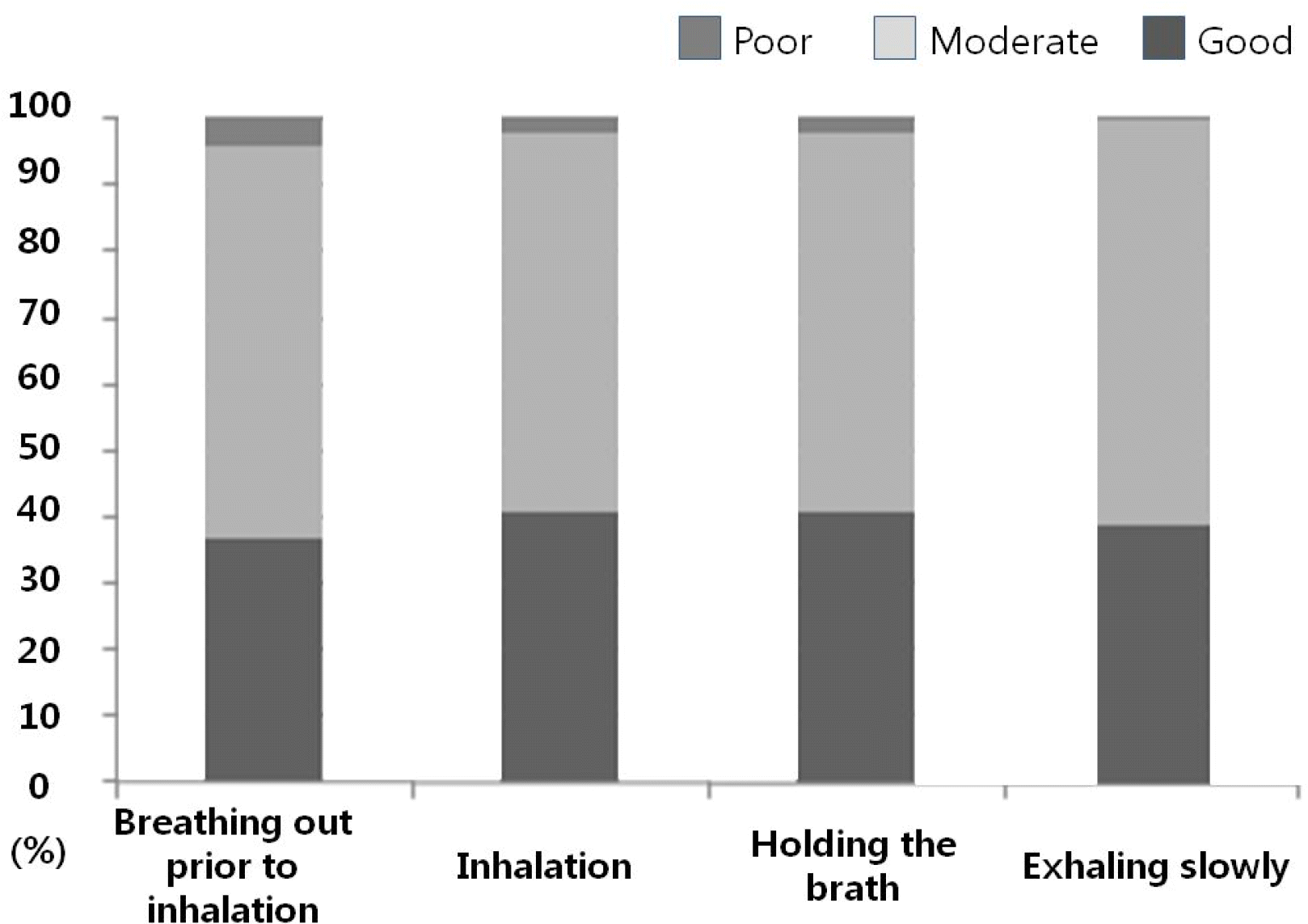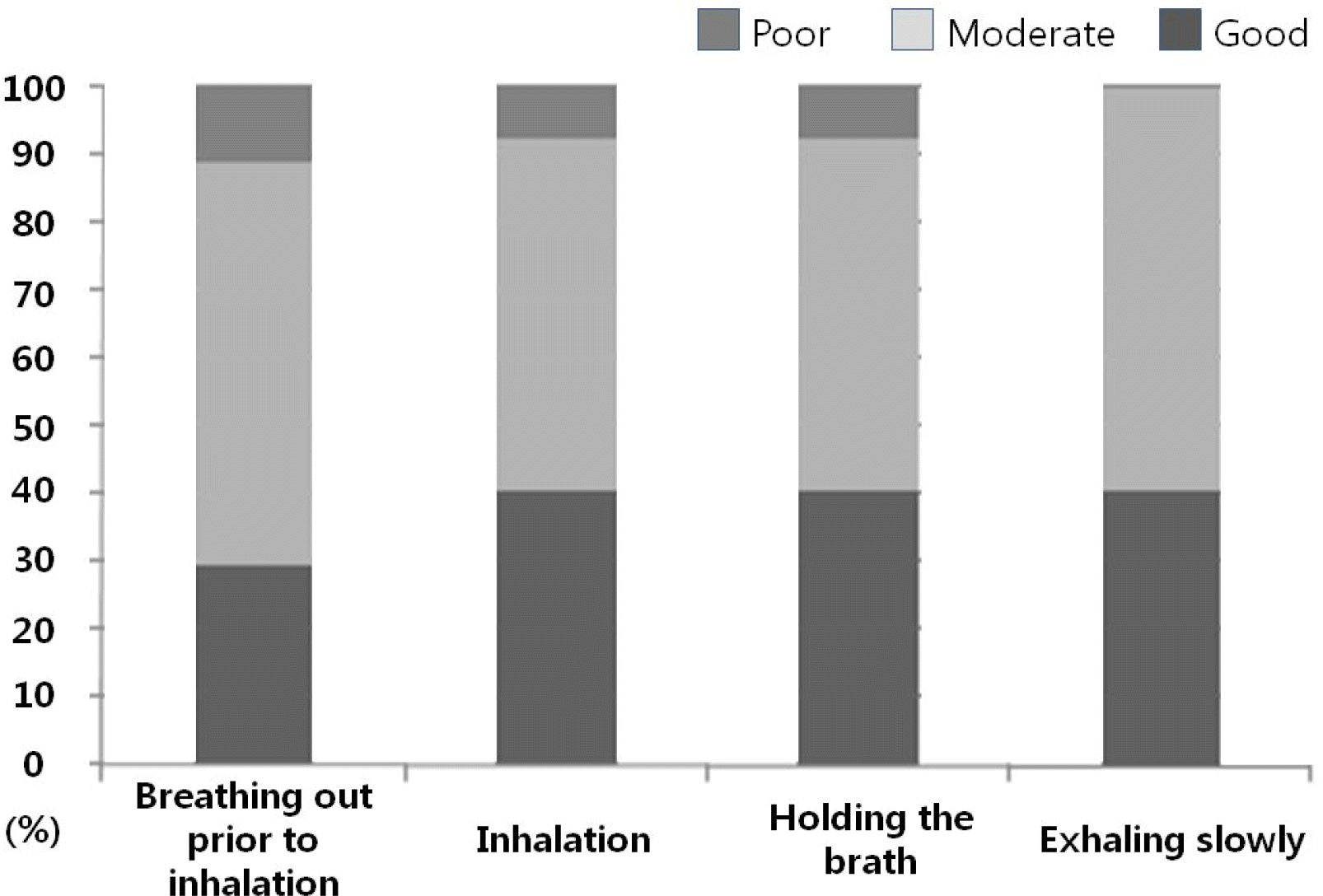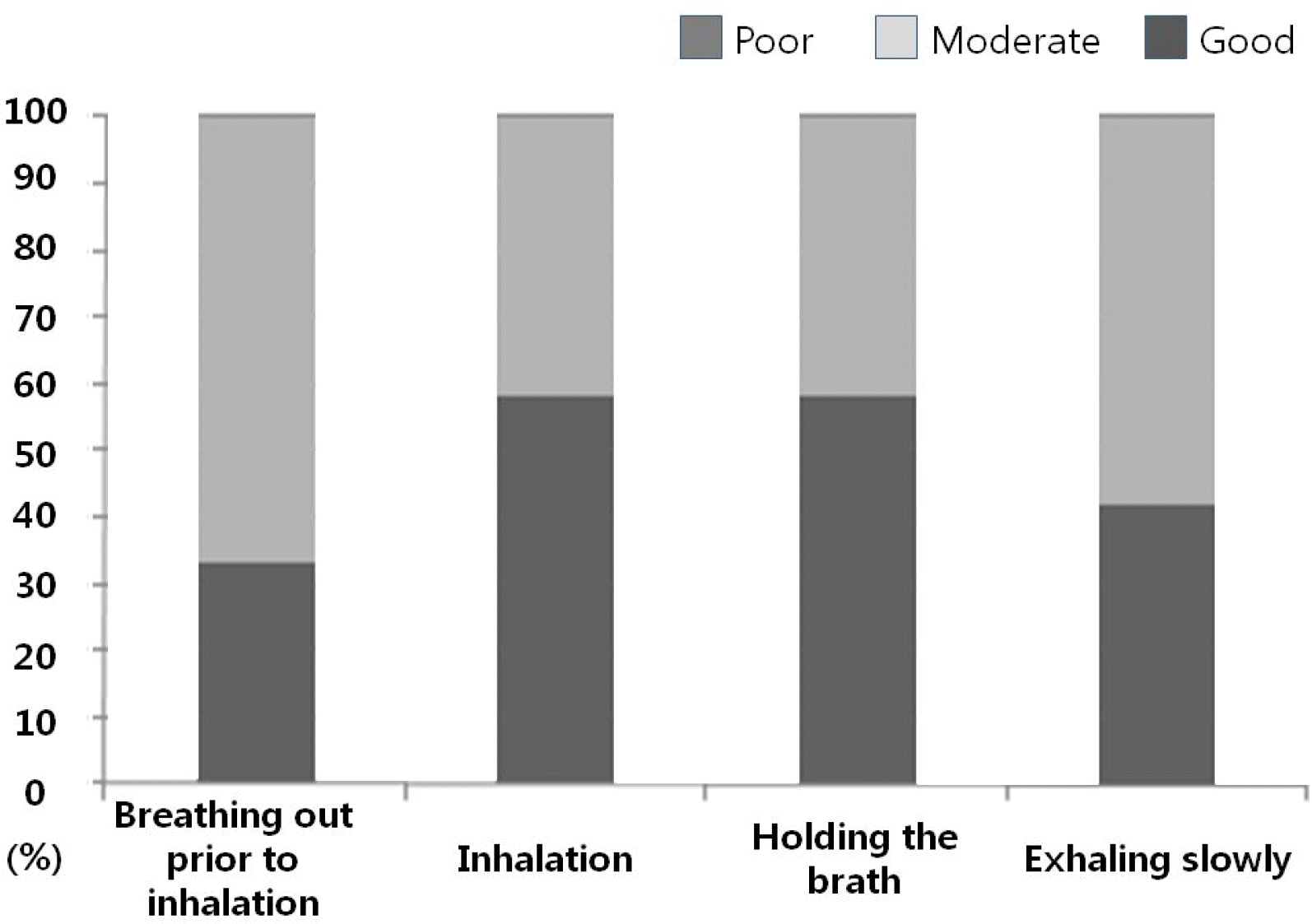Abstract
Purpose
Asthma inhalation therapy is important for the treatment of childhood asthma. Therefore, it is necessary to educate patients on the correct inhalation techniques. The purpose of this study was to determine the effectiveness and necessity of educating patients on the correct inhalation techniques.
Methods
A total of 86 patients with bronchial asthma and who were over 7 years old were enrolled and educated on handling inhaler devices for 2 years. The inhaler devices used were the diskus (n=27), turbuhaler (n=12) and metered dose inhaler with a spacer (n=47). Trained pharmacists provided the education. Four steps (breathing out prior to inhalation, inhalation, holding the breath, exhaling slowly) that were critical for handling each device were evaluated and each step was scored as good, fair or poor. We evaluated the symptom score (daytime cough, nighttime cough, sleep disturbance and limitation of activity) and lung function before treatment and 4 weeks later.
Results
Over 90.0% of the diskus users performed fair to good in each step. The symptom score and lung function at 4 weeks later after education were significantly improved (P=0.000). The turbuhaler users all performed fair to good on each step. The symptom score was significantly improved (P<0.005), but the lung function was not difference. Over 95% of the users of a metered dose inhaler with a spacer performed moderate to good on each step. The symptom score and lung function were significantly improved (P<0.05).
Go to : 
References
1. Walia M, Paul L, Satyavani A, Lodha R, Kalai-vani M, Kabra SK. Assessment of inhalation technique and determinants of incorrect performance among children with asthma. Pediatr Pulmonol. 2006; 41:1082–7.

2. Molimard M. How to achieve good compliance and adherence with inhalation therapy. Curr Med Res Opin. 2005; 21(Suppl 4):S33–7.

3. Giraud V, Roche N. Misuse of corticosteroid metered-dose inhaler is associated with decreased asthma stability. Eur Respir J. 2002; 19:246–51.

4. Cochrane MG, Bala MV, Downs KE, Mauskopf J, Ben-Joseph RH. Inhaled corticosteroids for asthma therapy: patient compliance, devices, and inhalation technique. Chest. 2000; 117:542–50.
5. Khassawneh BY, Al-Ali MK, Alzoubi KH, Batarseh MZ, Al-Safi SA, Sharara AM, et al. Handling of inhaler devices in actual pulmonary practice: metered-dose inhaler versus dry powder inhalers. Respir Care. 2008; 53:324–8.
6. Epstein S, Maidenberg A, Hallett D, Khan K, Chapman KR. Patient handling of a dry-powder inhaler in clinical practice. Chest. 2001; 120:1480–4.

7. Lee JK, Yang YH. Evaluation of an education program for patients with asthma who use inhalers. J Korean Acad Nurs. 2010; 40:202–12.

8. Crapo RO, Casaburi R, Coates AL, Enright PL, Hankinson JL, Irvin CG, et al. Guidelines for methacholine and exercise challenge testing-1999. This official statement of the American Thoracic Society was adopted by the ATS Board of Directors, July 1999. Am J Respir Crit Care Med. 2000; 161:309–29.
9. Dhand R, Fink J. Dry powder inhalers. Respir Care. 1999; 44:940–51.
10. Wieshammer S, Dreyhaupt J. Dry powder inha-lers: which factors determine the frequency of handling errors? Respiration. 2008; 75:18–25.

12. Fink JB, Rubin BK. Problems with inhaler use: a call for improved clinician and patient education. Respir Care. 2005; 50:1360–74.
13. McFadden ER Jr. Improper patient techniques with metered dose inhalers: clinical consequences and solutions to misuse. J Allergy Clin Immunol. 1995; 96:278–83.
14. Kamps AW, Brand PL, Roorda RJ. Determinants of correct inhalation technique in children attending a hospital-based asthma clinic. Acta Paediatr. 2002; 91:159–63.

15. Hindle M, Chrystyn H. Relative bioavailability of salbutamol to the lung following inhalation using metered dose inhalation methods and spacer devices. Thorax. 1994; 49:549–53.

16. Yu SK, Park SI, Park SY, Park JK, Kim SE, Kim JY, et al. The effect of repeated education using a computerized scoring system for the proper use of inhalation medicine. Tuberc Respir Dis. 2007; 63:491–6.

17. Savage I, Goodyer L. Providing information on metered dose inhaler technique: is multimedia as effective as print? Fam Pract. 2003; 20:552–7.

18. Mulloy E, Donaghy D, Quigley C, McNicholas WT. A one-year prospective audit of an asthma education programme in an outpatient setting. Ir Med J. 1996; 89:226–8.
Go to : 
 | Fig 3.Frequency of errors in each essential steps in metered dose inhaler (MDI) with spacer. |
Table 1.
Characteristics of Patients
Table 2.
Comparison of the Improvement of Symptom Score and Pulmonary Function Test after Education
| Diskus (n=27) | Turbuhaler (n=12) | MDI with spacer (n=47) | |
|---|---|---|---|
| Daytime cough | |||
| Before | 2.15 0.66 ± | 2.17 0.83 ± | 1.48 0.69 ± |
| After | 0.85 0.66 ± ∗ | 0.67 0.49 ± ∗ | 0.52 0.51 ±∗ |
| Nighttime cough | |||
| Before | 2.19 0.88 ± | 2.33 0.89 ± | 1.74 0.71 ± |
| After | 0.70 0.67 ± ∗ | 1.00 0.60 ± ∗ | 0.48 0.52 ± ∗ |
| Sleep disturbance | |||
| Before | 1.44 0.85 ± | 1.50 1.09 ± | 1.04 0.87 ± |
| After | 0.33 0.48 ± ∗ | 0.50 0.67 ± ∗ | 0.07 0.25 ± ∗ |
| Limitation of activity | |||
| Before | 1.67 0.92 ± | 1.08 0.79 ± | 1.02 0.77 ± |
| After | 0.37 0.49 ± ∗ | 0.33 0.49 ± ∗ | 0.11 0.31 ± ∗ |
| FEV1 | |||
| Before | 1.53 0.39 ± | 2.13 0.58 ± | 1.69 0.47 ± |
| After | 1.79 0.39 ± ∗ | 2.36 0.84 ± | 2.07 0.62 ± ∗ |
| FVC | |||
| Before | 1.62 0.40 ± | 2.21 0.65 ± | 1.73 0.46 ± |
| After | 1.88 0.40 ± ∗ | 2.43 0.88 ± | 2.13 0.62 ± ∗ |




 PDF
PDF ePub
ePub Citation
Citation Print
Print




 XML Download
XML Download